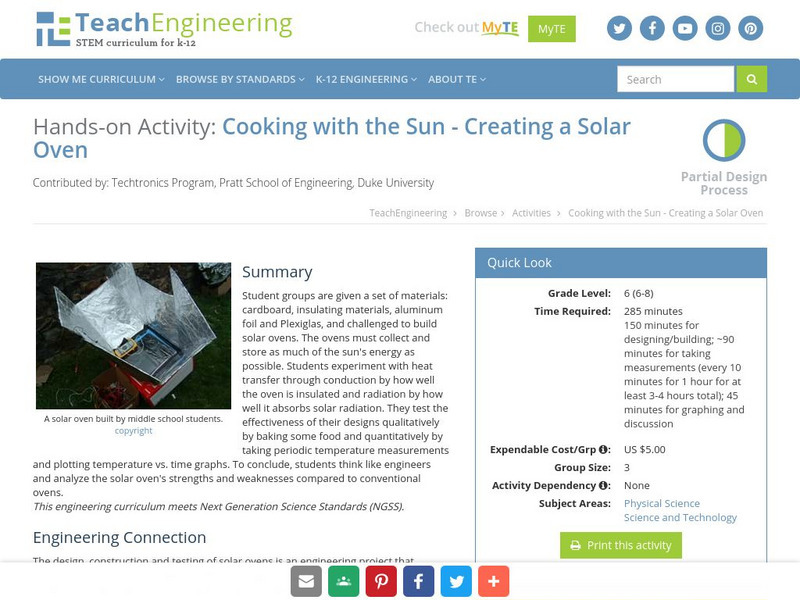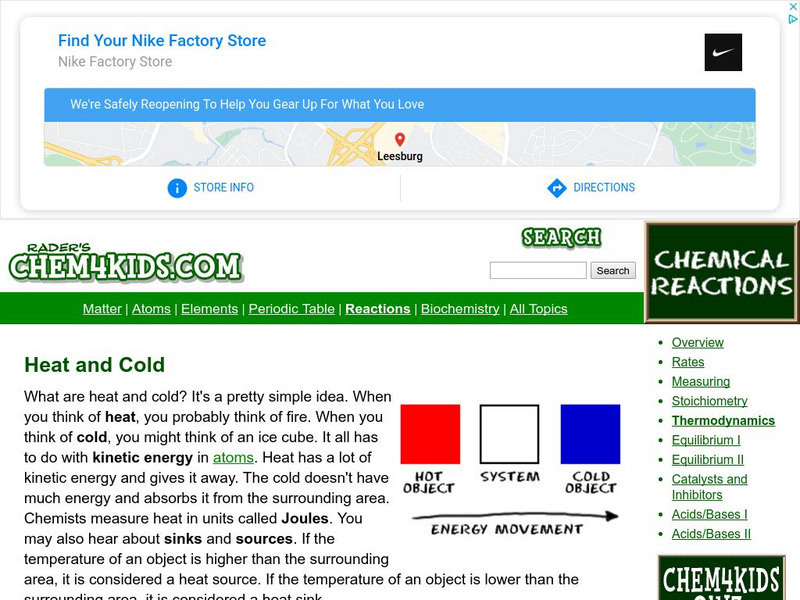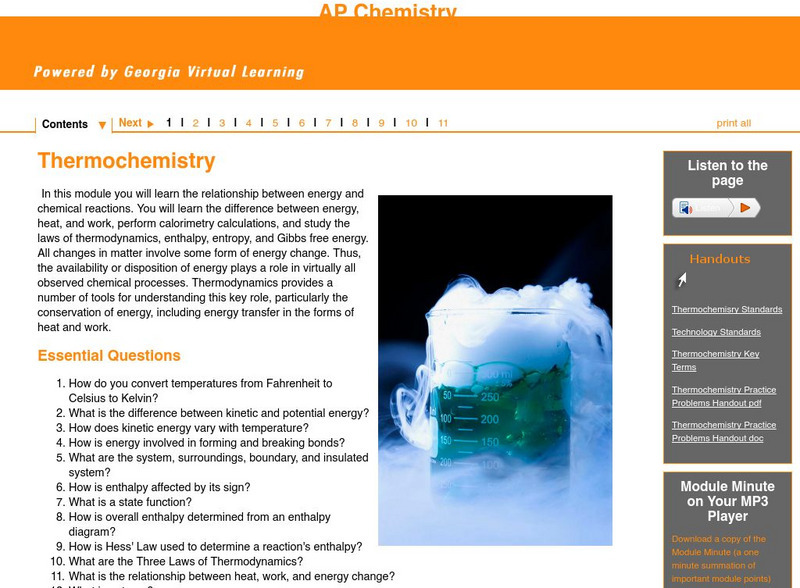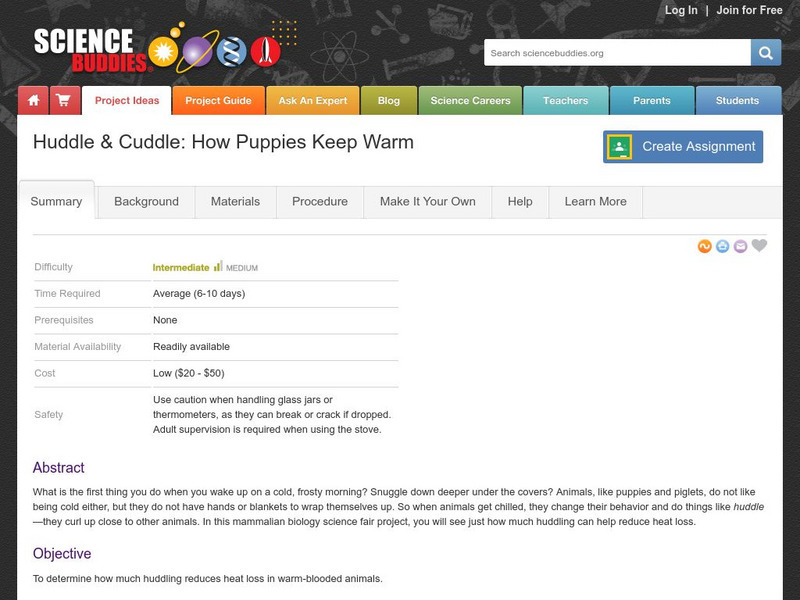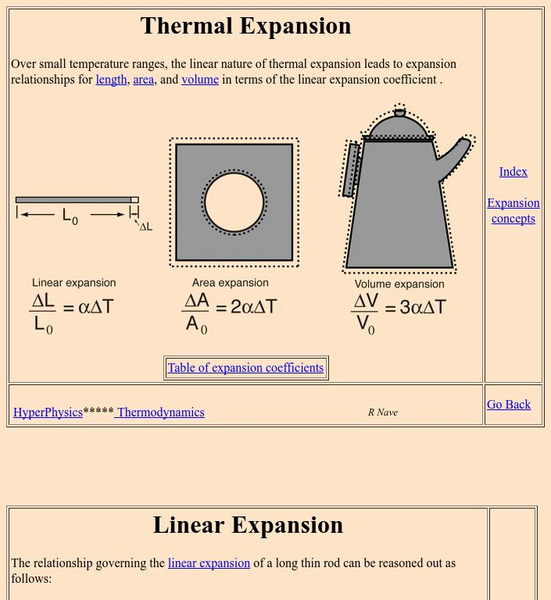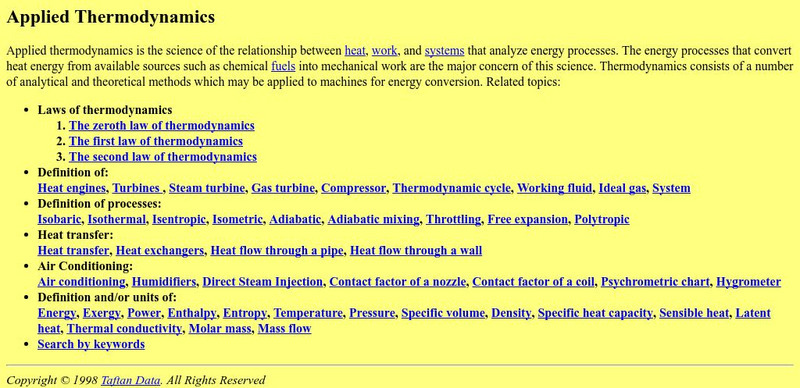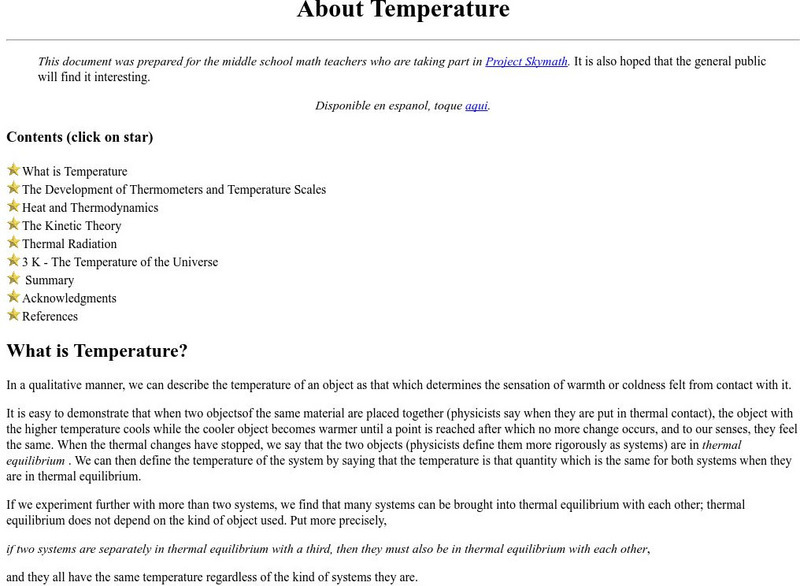Wikimedia
Wikipedia: Volumetric Heat Capacity
Wikipedia offers a brief definition of the term, "Volumetric heat capacity." Includes hyperlinked terms.
TeachEngineering
Teach Engineering: Solar Water Heater
Student teams design and build solar water heating devices that mimic those used in residences to capture energy in the form of solar radiation and convert it to thermal energy. This thermal energy is next transferred to water (to be...
TeachEngineering
Teach Engineering: Cooking With the Sun Creating a Solar Oven
For this activity, students will be given a set of materials: cardboard, a set of insulating materials (i.e. foam, newspaper, etc.), aluminum foil, and Plexiglas. Students will then become engineers in building a solar oven from the...
Chem4kids
Chem4 Kids: Thermochemistry
This site provides a general overview of thermochemistry, the division of chemistry that deals with temperature in chemical reactions. Content explores what heat and cold really are, the heat and energy around you, and a bit about Lord...
TeachEngineering
Teach Engineering: Let's Get Breezy!
Students apply an understanding of the concept of heat transfer through convection, conduction, and radiation as they use wireless temperature probes to investigate the heating capacity of different materials under heat lamps.
University of Colorado
University of Colorado: Physics 2000: Bose Einstein Condensation: Temperature and Absolute Zero
From the Physics 2000 site, this page exemplifies their usual superb discussion of the concepts of heat, temperature, and absolute zero. Using an entertaining series of cartoon characters, the page gives a very understandable discussion...
TeachEngineering
Teach Engineering: Conduction, Convection, and Radiation
With the help of simple, teacher-led demonstration activities, students learn the basic concepts of heat transfer by means of conduction, convection, and radiation. Students then apply these concepts as they work in teams to solve two...
Georgia Department of Education
Ga Virtual Learning: Ap Chemistry: Thermochemistry
In this module students learn the relationship between energy and chemical reactions, and understand the difference between energy, heat, and work. They perform calorimetry calculations, and study the laws of thermodynamics, enthalpy,...
Science Buddies
Science Buddies: Project Ideas: Huddle and Cuddle: How Puppies Keep Warm
In this mammalian biology science fair project, students will determine how much huddling reduces heat loss in warm-blooded animals. The Science Buddies project ideas are set up consistently beginning with an abstract, objective, and...
OpenStax
Open Stax: Convection
In this section of a college textbook, the topic of convection is explored. Understand how the process of convection transfers heat. Also learn how to calculate the rate of heat transfer by convection. Section also includes problems and...
American Chemical Society
Middle School Chemistry: Moving Molecules in a Solid
Students observe and describe, on the molecular level, how heating and cooling affect the motion of molecules in a solid.
Science Buddies
Science Buddies: Project Ideas: How Horses Keep Warm in the Wind
In this mammalian biology science fair project, students will learn about methods of heat transfer and determine the best direction in which horses should stand in a cold wind to maintain their core temperature. The Science Buddies...
Georgia State University
Georgia State University: Hyper Physics: Heat Engine Concepts: Carnot Cycle
The Carnot cycle is described, illustrated and explained. The Carnot efficiency equation is given and interactive JavaScript form allows the visitor to investigate the effect of the reservoir temperature and the sink temperature upon the...
Georgia State University
Georgia State University: Hyper Physics: Heat Engine Concepts: The Otto Cycle
Schematic diagrams illustrating the operation of a four-stroke engine cycle. Interactive buttons allow you to step through the various steps of each engine cycle. Each graphic is accompanied by an excellent explanation.
Science Education Resource Center at Carleton College
Serc: Heat Transfer Heat Absorption
Students will be given a chance to place their hands on two different objects and then predict on which an ice cube will melt more quickly. Students will make a prediction as to what will happen when balloons filled with air and with...
Physics Classroom
The Physics Classroom: Thermal Physics: Thermometers as Speedometers
Through interactive exercises and illustrated tutorials, students answer the fundamental questions: What is the reading on a thermometer the reflection of? What does temperature measure?
Physics Classroom
The Physics Classroom: Thermal Physics: Calorimeters and Calorimetry
Students learn about calorimeters and calorimetry in this illustrated, interactive physics tutorial.
Science Buddies
Science Buddies: Project Ideas: Transferring Heat by Convection in a Tank
In this engineering science fair project, students will determine the most effective method for quickly raising the temperature of a liquid in a tank. The Science Buddies project ideas are set up consistently beginning with an abstract,...
Science Struck
Science Struck: Conduction, Convection, and Radiation
Explains the concept of heat transfer and describes conduction, convection, and radiation which are the three modes of heat transfer. Includes formulas, examples, and applications.
Upper Canada District School Board
Tom Stretton's Chemistry Pages: Heat and Work Engines
Find out some history behind engines, and learn how thermal energy and work play a part in how engines run.
Georgia State University
Georgia State University: Hyper Physics: Expansion Concepts
An indexing page from Georgia State University Physics Department which includes links to various other pages with information pertaining to thermal expansion. From expansion coefficients to equations to calculation and practice pages,...
Georgia State University
Georgia State University: Hyper Physics: Bimetallic Strips
The operation of bimetallic strips is explained and illustrated. The principle of thermal expansion is related to their operation. A link to applications of bimetallic strips is provided.
Other
Taftan: Applied Thermodynamics
A definition of applied thermodynamics, the science of the relationship between heat, work, and systems that analyze energy processes. Related links.
University Corporation for Atmospheric Research
Ucar: About Temperature
This site from the University Corporation of Atmospheric Research provides a lengthy page covering numerous topics including the difference between heat and temperature, the use of different temperature scales, thermal expansion, how a...




